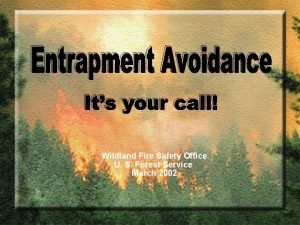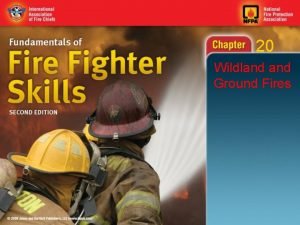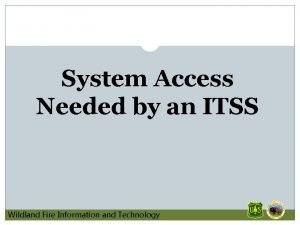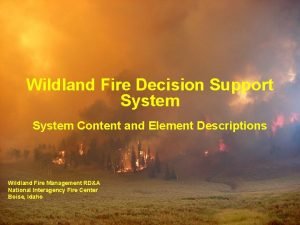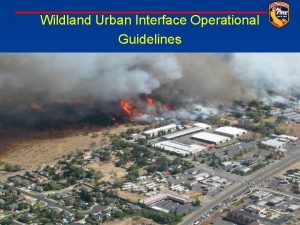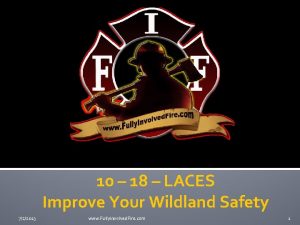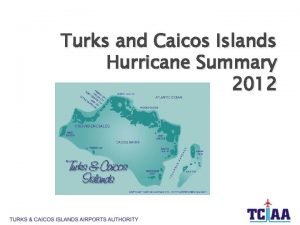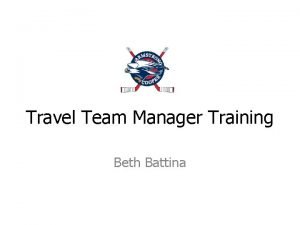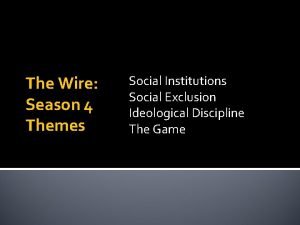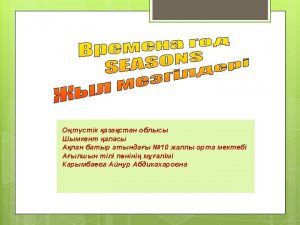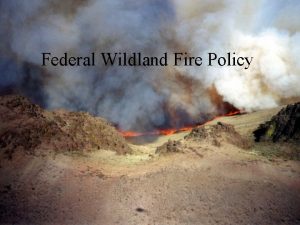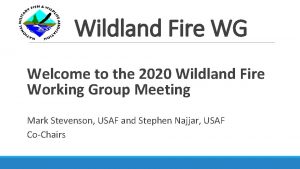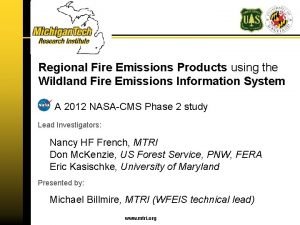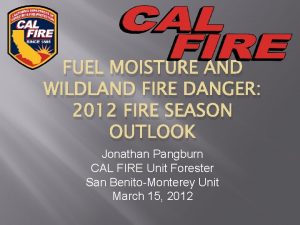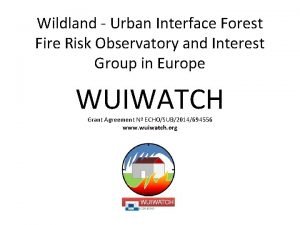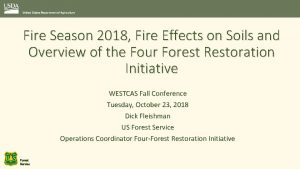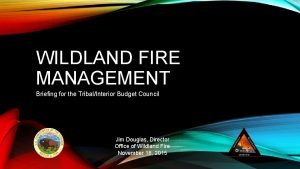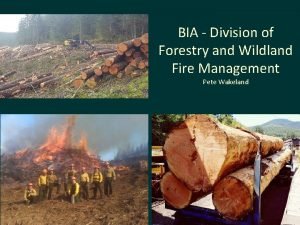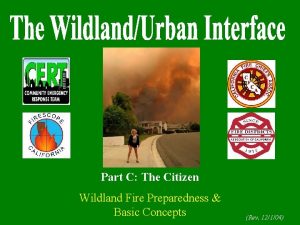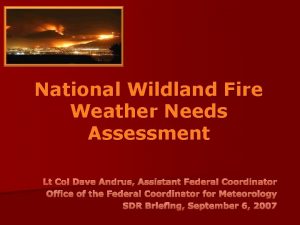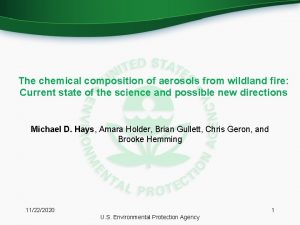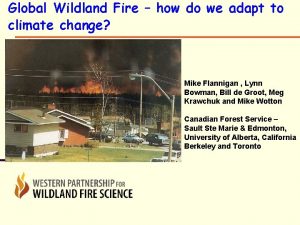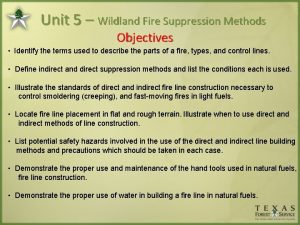1 2020 Wildland Interface Fire Season Preparation Teleconference





























- Slides: 29

1 2020 Wildland Interface Fire Season Preparation Teleconference: International Partnerships April 2 th, 2020 Prepared by: Rich Verbisky, NRCan-CFS, Dave Bokovay and Serge Poulin, CIFFC

2 International Wildland Fire Partnerships § Context and trends § Existing Arrangements/Mo. Us/Operating Plans § Process of Engagement: International resource requests and offers of assistance § Accessing international resources in a COVID-19 environment

Treed land in Canada has over 347 million hectares of forest land Proportion of area covered by trees © Her Majesty the Queen in Right of Canada, as represented by the Minister of Natural Resources, 2018

4 Wildland Fire Management in Canada • Provides scientific research, information and policy instruments as well as operational emergency management and decision support • Responsible for fire preparedness, response and mitigation in their own jurisdictions • Coordinates exchange of fire-fighting crews, equipment and information between jurisdictions NRCan CIFFC PTs OGDs • Several federal departments and agencies are involved in supporting provinces/territories and in managing fires on federal lands.

5 Overview Federal and provincial jurisdiction FEDERAL GOVERNMENT SHARED JURISDICTION PROVINCIAL & TERRITORIAL • International trade and relations • National policy and regulatory framework • Indigenous and Northern Affairs • Management of federal lands • National reporting • Science and technology • Environmental regulation • Own & manage 90% of Canada’s forests • Fight wildland fire • Develop legislation, regulations and policies • Allocate timber licenses • Collect stumpage fees • Collect data

6 The frequency and severity of forest fires in Canada is predicted to increase as climate change brings about warmer temperatures and less rainfall The Horse River wildfire (Fort Mc. Murray 2016) was the costliest natural disaster in Canadian history…… $3. 58 billion (losses according to the Insurance Bureau of Canada) $8. 86 billion (estimated total cost, including financial, physical and social factors - Mac. Ewan University)

7 2017/2018/2019 Wildfire Seasons – International personnel received in Canada § US – 47/12/418 § Australia – 235/28/0 § New Zealand – 85/67/0 § Mexico – 360 /742/1 § South Africa -0/0/45

8 2018 Fire Season 259 Resource Orders 6, 819 Fires 2, 250, 045 Hectares 3, 284 Personnel 51, 646 TPD 849 International Personnel Deployed International personnel accounted for 19, 810 person days = 38% of the total person days for all personnel in the 2018 fire season

9 2019 Fire Season 205 Resource Orders 4, 097 Fires 1, 836, 633 Hectares 3, 116 Personnel International Personnel 418 US 45 South Africa 1 Mexico International Personnel through Alberta Agreements 61 US (Idaho, Oregon and Montana State) 101 Mexico (State of Jalisco)

10 Canadian deployments to Australia ü 242 Canadian Personnel Deployed ü 11 deployments, (74 Resource Orders) fulfilled all requests from Australia ü 4 months continuous support. November 15, 2019 to March 11, 2020 ü Support roles: Incident Management, command, aviation, planning, logistics, operations and communications. ü 4 / 20 p Fireline Crews (Personnel from all Provinces, Territories, Parks Canada and CIFFC

11 Types of Instruments for International Engagement ü Mo. Us/Arrangements ü Operating Plans ü Compacts & Border Agreements ü Mutual Aid Agreements ü Open Call / Offers of Assistance ü International Partnerships ü Formal – North American Forest Commission; Canada-Mexico Partnership; International Model Forest Network; International Wildland Fire Conference; Megaflorestais; GOFC-GOLD… ü Informal …. .

12 MOUs/Arrangements: ü Provide a framework for one country to request and receive Wildland Fire Management Resources from the other country and to facilitate cooperation on wildland fire management related activities. ü NRCan-CFS and CIFFC typically jointly lead as Canadian participants in the development of International MOUs/Arrangements in consultation with P/Ts and GAC (treaty law division).

13 Current MOUs/Arrangements Country New Zealand United States Mexico Australia South Africa Costa Rica Title An Arrangement For The Exchange Of Wildland Fire Management Resources Between Canadian And New Zealand Participants Arrangement in the form of an exchange of notes between the Government of Canada and the Government of the United States of America Memorandum of Understanding for the Exchange of Wildland Fire Management Resources between Canadian and Mexican participants Arrangement between the Department of Natural Resources of Canada and Emergency Management Australia on the Exchange of Wildland Fire Management Resources Memorandum of Understanding between the Department of Natural Resources Canada and the Department of Environmental Affairs of the Republic of South Africa on Mutual Assistance and Cooperation on Wildland Fire Management Memorandum of Understanding between the Department of Natural Resources Canada, the Ministry of Environment and Energy of Costa Rica and the National System for Conservation Areas of Costa Rica on Mutual Assistance and Cooperation in Wildland Fire Management

14 Operating Plans ü Constitute a binding contract between participants to the MOU/Arrangement. ü Participants are typically wildland firefighting agencies. ü Operating Plans detail the terms and conditions regarding wildfire resource management sharing across international borders. This includes procedures for cross-border transfer of personnel, equipment, aircraft, invoicing and liability. ü Operating plans support MOUs/Arrangements but can also serve as a mechanism to access international assistance from countries with which Canada does not have an MOU/Arrangement. ü CIFFC as Canada’s designated coordinating authority leads on the development of Operating Plans which are signed by P/Ts. NRCan-CFS is not a signatory to Operating Plans.

15 Current Operating Plans Country Operating Plan New Zealand Operating Plan signed by CIFFC and all but two Canadian agencies. United States Operating Plan signed by CIFFC. Mexico Australia South Africa Costa Rica Operating Plan signed by CIFFC, BC, AB, SK, ON, PE. Other agencies plan to sign. Operating Plan signed by all Canadian Agencies. Operating plan signed by CIFFC, AB, BC. Operating plan in development

16 Compacts & Border Agreements ü Regional Forest Fire Compacts between Canadian P/Ts & the US have been developed to facilitate the efficient and timely flow of wildland fire management assistance across the border. ü Every Canadian province and territory (except NU) belong to an international Forest Fire Compact Members Great Lakes Forest Fire Compact Manitoba, Michigan, Minnesota, Ontario and Wisconsin Northeastern Forest Fire Protection Commission (NFFPC) Connecticut, Maine, Massachusetts, New Brunswick, New Hampshire, New York, Nova Scotia, Québec, Newfoundland & Labrador, Prince Edward Island, Rhode Island Vermont, the New England National Forests, the National Park Service, and the US Fish & Wildlife Service. Northwest Wildland Fire Alaska, Alberta, British Columbia, Yukon, Northwest Protection Agreement (Northwest Territories, Saskatchewan, Idaho, Montana, Oregon, Compact) Washington and Yukon Great Plains Compact Saskatchewan, North and South Dakota, Wyoming, Nebraska, Colorado, New Mexico ü Border agreements also exist between some PTs and their adjoining States. Enable immediate dispatch on initial attack. Usually quick and no exchange of funds.

17 Mutual Aid Agreements ü Canadian provinces/territories have Mutual Aid Agreements with foreign state/provincial governments on wildfire cooperation. ü Alberta + Jalisco (Mexico): Mutual Aid Agreement on forestry, focus on wildland fire fighter (WFF) and training exchange program to international standards. Jalisco has responded to Alberta’s calls for emergency aid in fighting fires on multiple occasions. ü British Columbia + State of Victoria (Australia): Mutual Aid Agreement for the exchange of wildland firefighting resources.

18 Open Call / Request and Offers of Assistance ü Arise when there is a need to issue an Open Call or offer for international wildfire fighting resources outside of existing Mo. Us/arrangements and beyond agency to agency contracts. ü In the unique circumstance of the need for an Open Call, CIFFC and NRCan along with key federal partners such as GAC, and coordinated by PS-GOC, work jointly to implement such a request for international assistance.

19 Process of Engagement - wildland fire management operations ü CIFFC is the national authority on wildfire management resources and is the lead partner on accessing domestic and international assistance. ü If there is a need for international assistance, CIFFC as Canada’s recognized coordinating authority, can invoke a number of existing instruments designed to facilitate the cross border flow of wildland fire suppression personnel and equipment. ü Engagement based upon protocols, standards, defined instruments and assessment.

20 CIFFC Planning ü National Preparedness Levels ü NPL 1 (low activity) to NPL 5 (extreme activity) Determined by - agency preparedness level (weighted) - current resource orders - domestic resource availability ü NPL 1 - 2 Duty Officer plans, 7 day window ü NPL 3 Triggers Strategic Planning Unit and Canadian Multi-Agency Coordinating Group

21 CIFFC Strategic Planning Unit ü Membership CIFFC Executive Director, Director of Operations and Coordination Centre Manager NRCan Weather Specialists and International Liaison Government Operations Centre (as required) ü Role Forward planning (14 - 30 day window) Sharing intelligence Linkage with international partners, NRCan and other Federal agencies (i. e. CBSA, T. C. , etc. )

22 Canadian Multi-Agency Coordinating Group ü Membership Senior Operational Managers (CIFFC Agencies) ü Role Multi-agency level strategic planning and decision Resource Availability and Allocation Assisting to set national priorities Conflict resolution forum

23 CIFFC Coordination Centre ü Staffed 7 days a week May 1 to Labour Day and as required throughout the year ü Role Information Sharing (Situation Report) Coordination of all resource requests Weekly planning calls Wednesday 12: 00 CDT NPL 1 - 2, resources on first come first served NPL 3 + direction of CMAC (if engaged)

24 Illustrative Schematic: Requesting International Assistance for Wildland Fire Management Canadian Interagency Forest Fire Centre (CIFFC) National Preparedness Level - 4 Status: : “Competition Exists nationally for Wildland Fire Management Resources” P/Ts/CIFFC partners make request based on current understanding of domestic capabilities. CIFFC unable to provide resource from domestic source CIFFC assess/develops operational suitability of options in relation to needs of CIFFC members P/T Agency makes request to CIFFC for resources “Filling gaps” RAAP* may be required CIFFC able to provide resource from domestic source No No MOU RFA open call develop Operating Plan MOU/ Op Plan exists Agency accepts option provided by CIFFC to meet need CIFFC Deploys

25 Illustrative Schematic: Requesting International Assistance for Wildland Fire Management Canadian Interagency Forest Fire Centre (CIFFC) National Preparedness Level - 5 Status: : “National level Wildland fire management resources are insufficient to meet current and anticipated activity” “Demand clearly exceeds supply” “international mobilization of wildland fire management resources is required” RAAP* implemented “RESET” of WFF required GOC ENGAGED P/T Agency makes request to CIFFC for resources CIFFC assess/develops operational suitability of options in relation to needs of CIFFC members No No MOU RFA open call develop Operating Plan MOU/ Op Plan exists Agency accepts option provided by CIFFC to meet need *RAAP - Resource Availability Allocation Protocol CIFFC Deploys

26 International Engagement: Offers of International Assistance – examples from the Horse River Fire (2016) Swedish PM Russian Minister A NAS NRCan-CFS PM Canada Mexico R CONAFO NRCan. CFS ADM NRCan DM te US priva sector GAC – Canadian Consulate State of Californi a PS Minister AB Gov. scientist ü Offers were often “shot-gun” in nature…. . (sent from various sources to various recipients) ü Offers diverse in nature (ranging from specific to wildland fire management to recovery, humanitarian, infrastructure, corporate, etc. ) ü Offers from “established” partners and others ü Format of offers can vary (tweets, formal letters, emails, phone calls…) ü Offers vary in capacity, extent, potential for use, reliability, time to deploy ü Responses to Wildland Fire Management Resource offers: ü have an established protocol ü involve key partners have specific roles/responsibilities

27 Process for Receiving Offers of International Assistance for Wildland Fire Management GOC ENGAGED CONSOLIDATE Offers compiled and distributed to relevant partners and tracked VALIDATE Reaffirmation of authenticity Offers may be vetted by SME/LO ASSESS Technical expertise required CIFFC protocols used NPL RESPOND CIFFC and/or joint appropriate Gov. of Canada representative if required Potential tools for various steps: ü Sorting matrix ü SOPs ü Standardized messaging ü National Preparedness Levels ü WGs/Technical committees ü SME/LO

28 Accessing international resources in a COVID-19 environment Canadian Missions: FSD 64 Emergency evacuation of non essentials and dependants (as of March 18, 2020). ABDJN ABUJA ACCRA ADDIS ALGER BAGLR BDGTN BEJING BERUT BGHDD BGOTA BGRAD BMAKO BUCST BSBGN CAIRO CHADG CHONQ CLMBO CRCAS CTONU DAKAR DELHI DHAKA DSLAM ERBIL GANZU GRGTN GTMLA HANOI HAVAN HOCHI HRARE ISBAD JKRTA JUBA KABUL KGALI KHRTM KNGTN KNSHA KYIV LAGOS LAPAZ LSAKA MANIL MMBAI MNGUA MOSCO MPUTO NLSTN NROBI OUAGA PNPEN PRNCE PSPAN QUITO RABAT RMLAH SDMGO SHNGI SSAL STAGO TGLPA TUNIS ULAAN VNTNE YNGON YUNDE Key Considerations: ü Bill C-13, the COVID-19 Emergency Response Act ü GAC/ IRCC: biometrics and visa processing ü GAC/CBSA: entry of foreigners for emergency response ü COVID-19 protocols: Public Health Agency Canada/ provincial/territorial

29 Next steps / Action items ü? ü? Preparedness: “a continuous cycle of planning, organizing, training, exercising, evaluating, and taking corrective action in an effort to ensure effective coordination during incident response”. Canadian Wildland Fire Management Glossary, CIFFC Oct 16, 2017
 Trigger point wildland fire
Trigger point wildland fire Pincer attack wildland fire
Pincer attack wildland fire Ftp.nifc.gov to ftp.wildfire.gov
Ftp.nifc.gov to ftp.wildfire.gov Wfdss training
Wfdss training Firescope structure triage
Firescope structure triage Ten standard firefighting orders
Ten standard firefighting orders Interface in java
Interface in java Areas of the screen that behave as if they were independent
Areas of the screen that behave as if they were independent Office interface vs industrial interface
Office interface vs industrial interface Interface------------ an interface *
Interface------------ an interface * Dimodium
Dimodium Interface fire alarm systems and elevator controls
Interface fire alarm systems and elevator controls Reichstag fire who was the fire starter
Reichstag fire who was the fire starter Damper interface panel
Damper interface panel Uttar pradesh fire prevention & fire safety rules, 2005
Uttar pradesh fire prevention & fire safety rules, 2005 A-e rwi
A-e rwi Fight fire with fire definition
Fight fire with fire definition Turks and caicos hurricane season
Turks and caicos hurricane season Acyha
Acyha The wire themes
The wire themes Gatsby chapter 8 summary
Gatsby chapter 8 summary January february march april may
January february march april may Summer winter spring autumn
Summer winter spring autumn Words to describe spring
Words to describe spring Nothing happens twice season 2
Nothing happens twice season 2 Demonstrate rhyme
Demonstrate rhyme Summer poem
Summer poem Illinois boys lacrosse association
Illinois boys lacrosse association First day of each season
First day of each season Strabger things genre
Strabger things genre
